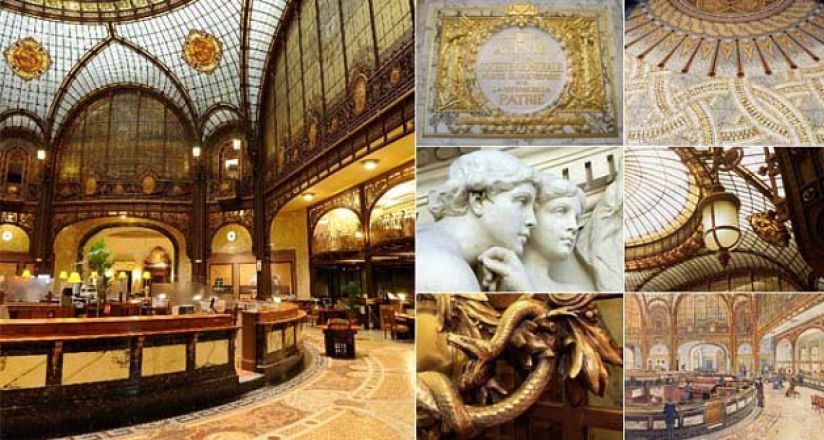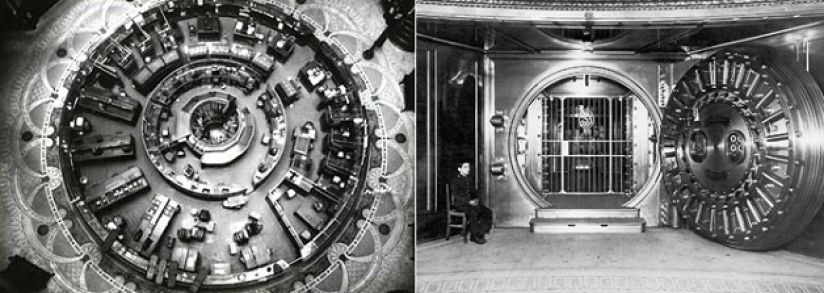Innovation and Architecture
The Central Branch: a “banking palace” of the Belle Époque
At No. 29 Boulevard Haussmann, right in the centre of Paris, can be found the building which has served as the Group’s headquarters for the past century. A true architectural masterpiece, certain parts of which are now featured in the list of Historic Monuments.

At the beginning of the 20th Century, Societe Generale made the decision to acquire new headquarters. Too overcrowded in its offices at 54-56 rue de Provence, the bank became interested in a block of buildings behind the Opera in Boulevard Haussmann. Competing with Galeries Lafayette, they officially acquired it on the 2nd April, 1906. The Board of Directors decided to engage the services of the architect Jacques Hermant, a teacher at the Beaux-arts de Paris, to transform these apartment buildings, occupying 2,600 square metres, into a banking establishment.
The works lasted six years. On the 26th June, 1912, the new headquarters was opened at 29 Boulevard Haussmann, in the presence of baron Hély d’Oissel, president of Societe Generale. The result exceeded all expectations. On the exterior façade, the ground floor and mezzanine are finished in horizontally rusticated masonry, punctuated by arched bays with grilles over a plinth of Comblanchien stone. In the Boulevard Haussmann, by virtue of special dispensation, the centre line has been redesigned across its length in such a way as to create a pattern above the entrance of number 29. Its upper part is a pediment decorated with allegoric sculptures. On the third floor, against the pillars and between the balconies, six Corinthian style statues were installed in 1919 to illustrate various aspects of commerce and industry. Three large bays made up the entrance. Their vaults are adorned with carved grotesques.
Open on all sides, the grand central hall is of a luxurious, innovative design. The trapezoidal room occupies most of the ground floor, with a great circular counter in the centre, nicknamed “the cheese”. In 1919, a mezzanine was built to make extra space for the staff. The centrepiece of the hall is the splendid pinnacled dome which overhangs it. It is suspended 23 metres above the ground from the roof with a metal, umbrella-like structure composed of a self-supporting system of fine steel profiles. Glass and metal blend harmoniously to form an enclosed space while preserving the overhead illumination. The 18 metre diameter dome, designed by master glass craftsman Jacques Galand, displays an elegant gradation of colours. It is made up of 51 tapered parts arranged from a central rose.
The interior decor contributes to the charm of the building. The four arcatures each bear a coat of arms in the centre, representing the Société Générale in Paris, Lyon, Marseille and Bordeaux. Bronze medallions decorate their bases, and symbolise the bank’s activities throughout France. The corners are embellished with the monogram “SG”. Decorative ironwork is made up of oak leaves and acorns and the whole is enclosed by a wrought iron railing. The mosaic tiled floor is the work of ceramicists Alphonse Gentil and François-Eugène Bourdet. Around the hall’s rotunda, a plant pattern of interwoven and knotted leaves forms an enormous rosette. On the floor, twelve ornamentally embossed openwork copper plaques conceal the heating and ventilation ducts.

The basement contains the strong rooms, all in steel. These are laid out on four levels, the lowest being 11 metres below the ground. An impressive circular door, clad in shiny steel with gold and silver highlights guards the only entrance. Designed by locksmiths Fichet, the piece was constructed in the Creusot (iron working centre of France), transported by rail to Paris and then brought to the Boulevard Haussmann on a dray pulled by a team of nine horses. The diameter of the exterior door is 2.76 metres. It weighs 18 tonnes, and its armour plating is 40 centimetres thick. An access drum connects it to a second reinforced door. Inside the rooms contain 399 strong rooms, accounting for a total of 8,134 safety deposit boxes and 22 safes. These basement rooms are only opened progressively for clients.
Today the Central Branch still retains its original character, to the great pleasure of clients and employees alike. It is open to the public for Heritage Days (a cultural event in Europe). Since 1915, this building has housed the headquarters of the bank and, in spite of the management board having moved to the business centre in Paris-la Défense, it remains so.
© Archives Historiques Société Générale